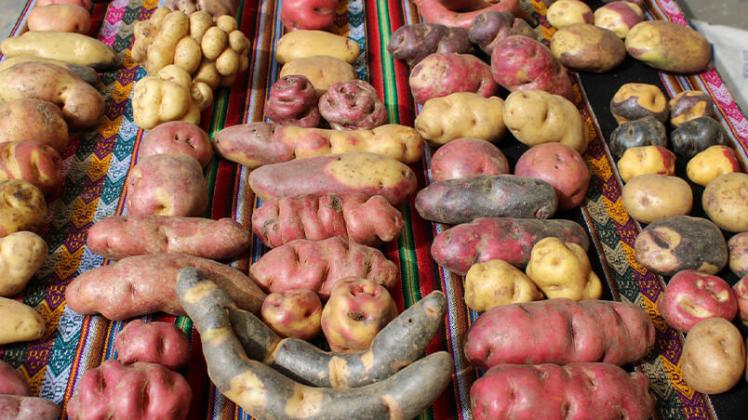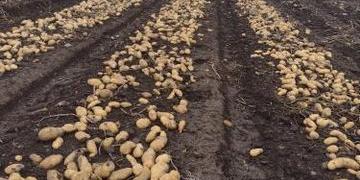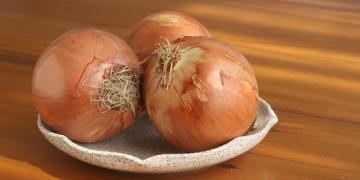Peru: "Fair pay for producers is essential to promoting native potato production."
Peruvian native potatoes have conquered haute cuisine for their flavor, diversity, and cultural value, but they still face barriers to reaching the tables of all Peruvians.

Chef Andy Falconi, instructor at Inteci and advocate for sustainable cuisine, analyzes the challenges and opportunities for revaluing it inside and outside of restaurants.
Why are more and more fine -dining restaurants prioritizing the use of native potatoes on their menus ? What factors explain this trend ?
The main factor is quality. Native potatoes are a product of excellence, comparable to luxury ingredients like foie gras or truffles from France. They are not only tasty and visually appealing—with intense colors and unique textures—but also nutritious and represent a cultural heritage unique to Peru, with thousands of varieties found nowhere else in the world. I think that’s where the path leads.
ꟷ Is the revaluation of these potatoes also motivated by cultural reasons?
Partly, but I’d say it’s not yet a determining factor. What’s had the greatest influence has been the promotional and awareness-raising work done in previous years. However, I do believe the cultural component can be an important catalyst for generating a greater connection with these ancestral products. And this revaluation should not only occur with potatoes, but also with other Andean crops.
ꟷWhich are the native varieties most in demand by chefs and why ?
The most commonly used varieties in haute cuisine restaurants are the purple potato, the oxeye potato, and the bull’s blood potato, among others. They have high nutritional value (because they are rich sources of antioxidants and other elements) and visual value, and provide unique textures, ideal for purées or preparations requiring a sandy consistency. Furthermore, their chromatic diversity makes them very attractive for serving dishes.
Sustainable cuisine
ꟷ What differentiates them from commercial varieties?
ꟷ Primarily, their richness of colors and textures, something not found in commercial potatoes. While commercial potatoes tend to be uniform, native potatoes offer a wide range of colors, from purple to veined. But there’s something even more important: most haute cuisine restaurants worldwide are embracing what’s known as sustainable cuisine, meaning they prefer ingredients that come from sustainable agricultural practices. In the case of Peruvian native potatoes, most are grown without pesticides, in traditional systems that respect the land and biodiversity and natural cycles. This is a key difference compared to commercial potatoes.
ꟷ Has sustainable cuisine become a decisive criterion in haute cuisine ?
Definitely. More and more chefs are opting for ingredients that are not only tasty but also environmentally responsible. This philosophy is transforming the way we think about cooking: it’s not just about innovation, but also about protecting what we eat and where it comes from.
ꟷ Is the consumption of native potatoes limited to haute cuisine or is it reaching the general public ?
ꟷ It’s still very focused on prestigious restaurants. The public is familiar with them thanks to them, but they haven’t fully incorporated them into their daily diet.
ꟷ Why ?
In part, this is due to a lack of knowledge about how to prepare them, and also because access to them is limited and their price is high for the general population. In Lima, for example, there are only 5 to 10 varieties, while there are more than 3,000 registered in the country.
And how much do native potatoes cost in Lima, for example? Those found in our city’s supermarkets cost between 10 and 12 soles per kilo , compared to commercial varieties that cost around 3 soles, or at most 5 soles , a price that is unaffordable for most consumers. Nor do producers receive fair treatment in terms of prices in supermarkets. For this reason, producers prefer to market them in their own regions and even prefer not to harvest them.
Strategies to boost consumption
ꟷ What is needed to make them available to more people ?
There are several challenges. The first is availability: they are unavailable in most small markets, and in supermarkets, their price is high, between 10 and 12 soles per kilo, well above the 3 or 5 soles that a commercial potato costs. The second is the lack of outreach campaigns informing the public about the properties, uses, and benefits of these varieties. A real connection between consumers and the richness of our native potatoes has not yet been achieved. And the third point, perhaps the most important, is the need to build a fairer and more direct distribution chain, where producers receive adequate compensation. Today, despite the fact that a kilo sells for more than 10 soles, many farmers don’t even receive 20% of that value. One would think they should get at least half, but the reality is different. Without fair payment, it is very difficult to talk about true sustainability.
ꟷ Does the gastronomic boom of these potatoes really benefit farmers?
In part, yes. High-end restaurants like Central and others have established direct links with producers, guaranteeing fair and sustainable prices. This relationship allows farmers to continue cultivating native varieties, striving for their practices, and preserving ancestral knowledge. But it’s still an exception. There’s still a long way to go before this model becomes widespread and reaches the entire country.
Without intermediaries
ꟷ How does this articulation between restaurants and producers take place ?
It happens through direct partnerships. Chefs approach farmers, often in their own communities, to purchase the product without intermediaries. But this model is still limited. Not everyone has the logistical resources to replicate it, and many producers prefer to sell in their region because shipping to Lima is expensive, and again, the payment isn’t always fair.
Solidarity chain from the field to the table
What role should the State and other institutions play ?
Fundamental. A clear policy is needed to promote access, fair payment, and coordination between producers, markets, and kitchens. The role of culinary schools, universities, and local governments is also key. It’s a collective effort. If we want Peruvian cuisine to be truly sustainable, we must build a solidarity chain from farm to table.
Native potatoes in popular cuisine: On the right, grilled chicken accompanied by multicolored native potatoes; on the left, causa made with red, purple, and yellow-fleshed potatoes. Photo: Marco Bazalar Reyes, director of Rock & Sazón.
Without promotion and without education, change does not come.
ꟷ What can be done to ensure that popular restaurants also include native potatoes on their menus ?
Promotional campaigns, like the ones we ran 17 years ago. In 2008, "Este Pechito Come Papa" (This Little Chest Eats Potatoes), which was very successful, were created. Commercials were created, fairs, festivals, and contests were organized. This allowed more varieties to reach the markets. Today, with the political situation so unstable, these types of actions have disappeared. But without promotion and food education, change doesn’t come. Chefs are making efforts to include native potatoes in popular and accessible dishes , such as broster or salchipapa (fried potatoes). In this way, they get people to learn about this ancient crop.
And what role does culinary training play? Are young chefs interested in these products?
There’s a lot of interest. There’s passion for our work, but also frustration. Many students work to pay for their studies and have no way of accessing these potatoes because of their high prices. If we want to train chefs committed to sustainability, we must facilitate their access to ingredients that represent our biodiversity. Because there’s no point in teaching them about native potatoes if they can’t cook them.
Fuente:




